Metropolitan Nashville Police Department
The Metropolitan Nashville Police Department is the primary provider of law enforcement services for Metropolitan Nashville and Davidson County, Tennessee. The MNPD covers a total area of 526.1 square miles (1,363 km2) that encompasses everything from high density urban locations to rural areas.
| Metropolitan Nashville Police Department | |
|---|---|
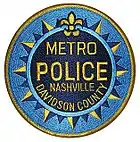 | |
| Abbreviation | MNPD |
| Agency overview | |
| Formed | 1806 |
| Employees | 1,757 (2020) |
| Annual budget | $289 million (2021)[1] |
| Jurisdictional structure | |
| Operations jurisdiction | Nashville, Tennessee, United States |
| Size | 525.94 sq mi (1,362.2 km2) |
| Population | 665,498 (2018) |
| Legal jurisdiction | Nashville and Davidson County, Tennessee |
| General nature | |
| Operational structure | |
| Officers | 1315 |
| Agency executive |
|
| Precincts | 8
|
| Facilities | |
| Airbases | 1 |
| Police Boats | 13 |
| Helicopters | 8 |
| Dogs | 18 |
| Horses | 12 |
| Website | |
| www | |
Composition and organization
The department personnel includes over 1450 full-time sworn members. The department responds to more than 950,000 police calls per year on average. The most recent census ranked Nashville as the 21st largest U.S. city. In 2000 the Department of Justice ranked the Metropolitan Nashville Police Department as the 36th largest U.S. police department.
The department is configured in a decentralized format, providing its precinct commanders with control of their own resources to address issues and crime trends in their areas. The department is divided into eight precincts: North, South, East, West, Central, Hermitage, Madison, and Midtown Hills. A precinct is designed similarly to a medium-sized police department, with uniform patrol, undercover officers, directed patrol officers, plainclothes detectives, and other specialties. On February 2019, a new headquarters was opened at 600 Murfreesboro Pike. This replaced the old headquarters, which was located at 200 James Robertson Parkway.
The precincts are supported by Administrative Services, Investigative Services, and Special Operations Division personnel, all in an effort to deter, detect, prevent, and respond to criminal trends in the precinct areas. The department's entire focus is on how to quickly identify trends and implement initiatives that address them.
Rank structure
The rank structure of the MNPD is as follows:
| Title | Insignia |
|---|---|
| Chief of Police |  |
| Deputy Chief | |
| Commander | |
| Captain | |
| Lieutenant | |
| Sergeant | |
| Field Training Officer | |
| Police Officer/Detective | |
| Police Officer Trainee |
S.W.A.T. Team
In 1976 the Metropolitan Nashville Government formed a highly flexible mobile strike force to concentrate on police problems that might otherwise go unchecked in Nashville due to the limitations imposed on field personnel in supplying day-to-day services. This early concept became the foundation for the department's Metro Unique Situation Team, known then as M.U.S.T.
This team was placed under the direct control of the Metro Police Department's Training Academy Director and its members were appointed from the training academy's roll. In 1979 the team was renamed the Special Weapons and Tactics Team (S.W.A.T.) and in 1983, its membership was opened to personnel throughout the department.
SWAT members are specialists selected, trained, and equipped to resolve high-risk tactical problems. SWAT personnel assist in the department's response to unusual and high-risk tactical situations. The members have primary assignments from virtually all sections within the department and come together for training and operations. Their constant specialty training and flexibility are the key elements in keeping abreast of a rapidly changing society and the complex problems it generates. The team conducts over 125 SWAT-related missions per year and is equipped with a Lenco BearCat armored rescue vehicle.
The team responds to several categories of tactical situations including:
- Barricaded person situations
- Sniper/counter-sniper situations
- Hostage situations
- High-risk warrant service operations
- Protecting high value persons and property
- Search and rescue operations
- High-risk tactical surveillance and/or narcotics enforcement operations
- Tactical waterborne operations

- High angle, elevated, and aviation operations
- Covert/undercover tactical operations
- Hazardous material, clandestine lab and weapons of mass destruction situations
- Special circumstances such as crowd control and rural searches
In 2004, the Metropolitan Nashville Police Department activated a portion of its SWAT team members to a full-time status. The unit is a plainclothes versatile SWAT unit with its primary focus as combating high-risk suspects who have outstanding warrants. The Special Response Tactical Unit is staffed by active SWAT Team members. Based on the unit's primary tasks of tracking down violent repeat offenders, service of high-risk search/arrest warrants, and assistance with preplanned high-risk operations, the unit is flexible in its shifts and days off.
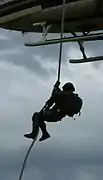 Fast Roping
Fast Roping Police OH-58 Helicopter
Police OH-58 Helicopter Sniper and Observer
Sniper and Observer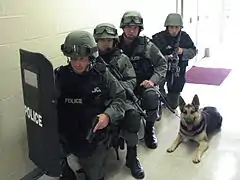 SWAT and Tactical K-9
SWAT and Tactical K-9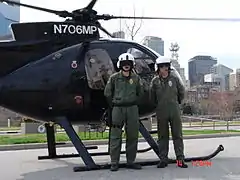 Police MD500 Helicopter
Police MD500 Helicopter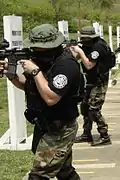 Non-Dominant Hand Range Work
Non-Dominant Hand Range Work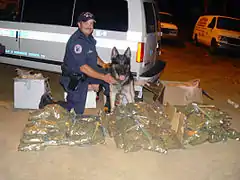 Drug Detector K-9
Drug Detector K-9 Police Vehicles
Police Vehicles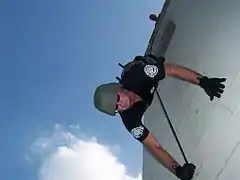 On Rope
On Rope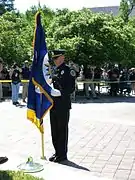 Drill and Ceremony Team Posting the colors
Drill and Ceremony Team Posting the colors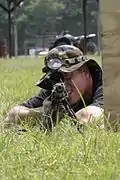 Sniper Range Work
Sniper Range Work Search Warrant Service
Search Warrant Service
Operation Safer Streets
Since 2005, The Metropolitan Nashville Police Department has been involved in Operation Safer Streets. Due to the growing gang problem on the streets of Nashville with gangs such as Kurdish Pride, MS-13, Bloods, and Crips, the Department has set up surveillance in the South Nashville neighborhoods to put pressure on the gang members. The team had originally only 14 officers who worked Friday, Saturday, and Sunday. These 14 officers stepped up Patrol in areas that have had a high concentration of gang activity, which include Madison and Antioch areas. In March 2008, the Department added 23 more officers to the anti-gang team. Then-Chief of Police Ronal W. Serpas stated that this step up in patrol was intended to send a message that he would not tolerate gang activity in Nashville.
In August 2009 Nashville appeared on Season Four Episode 23 (Hunt and Kill) of the TV Show "Gangland" featuring the street gang, "Brown Pride". This show highlights several local gang members, both arrested and out on the street, who talk about their lives in the gangs.[2]
Black Lives Matter Nashville disputes that Operation Safer Streets is effective and alleges that the program has disproportionately affected black and brown neighborhoods. [3]
References
- Sullivan, Carl; Baranauckas, Carla (June 26, 2020). "Here's how much money goes to police departments in largest cities across the U.S." USA Today. Archived from the original on July 14, 2020.
- "Archived copy". Archived from the original on 2015-11-17. Retrieved 2015-11-16.CS1 maint: archived copy as title (link)
- https://wpln.org/post/on-operation-safer-streets-a-divide-between-nashville-police-and-black-lives-matter/
Sources
- Ashmore, Eddie (2006). TENNESSEE LAWMAN History of the Men and Women behind the Badge. Turner Publishing. ISBN 1-59652-247-X.
- Metropolitan Nashville Police Department (2006). Metropolitan Nashville Police Annual Report. Nashville: Metro Government Printing Office.
- Metropolitan Nashville Police (2007) Web site http://www.police.nashville.org/
- United States Census Bureau (2006). Population Estimates.
- United States Department of Justice (2000). Local Police Department Estimates.

